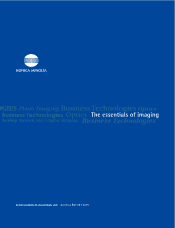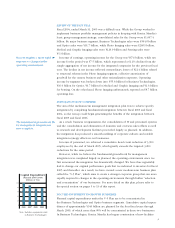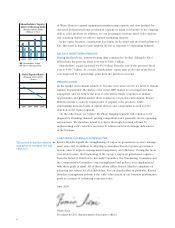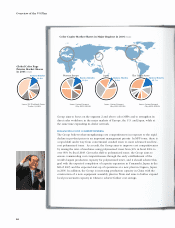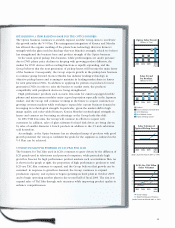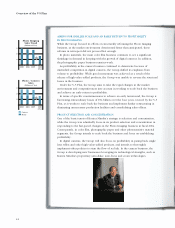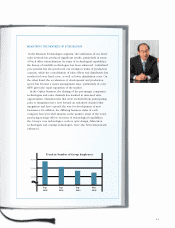Konica Minolta 2005 Annual Report Download - page 5
Download and view the complete annual report
Please find page 5 of the 2005 Konica Minolta annual report below. You can navigate through the pages in the report by either clicking on the pages listed below, or by using the keyword search tool below to find specific information within the annual report.
3
REVIEW OF THE PAST YEAR
Fiscal 2004, ended March 31, 2005 was a difficult year. While the Group worked to
implement business portfolio management policies in keeping with Konica Minolta’s
basic group management strategy, consolidated sales for the Group were ¥1,067.4
billion. By major business segment, Business Technologies sales were ¥564.8 billion
and Optics sales were ¥91.7 billion, while Photo Imaging sales were ¥268.5 billion,
Medical and Graphic Imaging sales were ¥129.9 billion and Sensing sales were
¥5.3 billion.
In terms of earnings, operating income for the Group was ¥67.6 billion, while net
income for the period was ¥7.5 billion, which represented a 61.1% decline from the
simple aggregation of net income for the integrated companies for the previous fiscal
year. The decline in net income reflected extraordinary losses of ¥21.4 billion related
to structural reforms in the Photo Imaging segment, collective amortization of
goodwill for the camera business and other rationalization expenses. Operating
income by segment was broken down into: ¥55.8 billion for Business Technologies,
¥16.0 billion for Optics, ¥6.7 billion for Medical and Graphic Imaging and ¥1.6 billion
for Sensing. On the other hand, Photo Imaging unfortunately reported an ¥8.7 billion
operating loss.
INTEGRATION NOW COMPLETE
The aim of the medium-term management integration plan was to achieve speedy
integration by completing fundamental integration between fiscal 2003 and fiscal
2004, so the Group could begin generating the benefits of the integration between
fiscal 2005 and fiscal 2006.
As a result, business reorganization, the consolidation of IT and personnel systems
and the consolidation and elimination of domestic and overseas sales offices as well
as research and development facilities proceeded largely as planned. In addition,
the integration has produced a smooth melding of corporate cultures and notable
integration synergy effects in our businesses.
In terms of personnel, we achieved a cumulative head count reduction of 3,900
employees by the end of March 2005, which greatly exceeds the targeted 3,200
reductions for the same period.
However, while we believe the fundamental groundwork for management
integration was completed largely as planned, the operating environment since we
first announced the integration has dramatically changed. We have thus regrettably
had to change our original performance goals that we indicated to investors for fiscal
2005 and thereafter. As a result, we have created a new medium-term business plan
called the “V-5 Plan”, which aims to create a stronger corporate group that can more
rapidly respond to changes in the operating environment through further “selection
and concentration” of our businesses. For more detail on this plan, please refer to
the special section on pages 5 to 13 of this report.
FOCUSED INVESTMENT IN GROWTH BUSINESSES
Planned capital expenditures under the V-5 Plan are to be concentrated in
the Business Technologies and Optics business segments. Cumulative capital expen-
ditures of approximately ¥340 billion are planned for the four fiscal years through
March 2009, of which more than 80% will be concentrated in these two businesses.
In Business Technologies, Konica Minolta has begun construction of new facilities
The fundamental groundwork
for management integration is
now complete.
Success requires a more rapid
response to changes in the
operating environment.
0
100
80
60
40
20
Capital Expenditure
(Planned 2006–2009)
(Billions of Yen)
20072006 2008 2009
0
Note: Includes equipment rental
in Business Technologies

